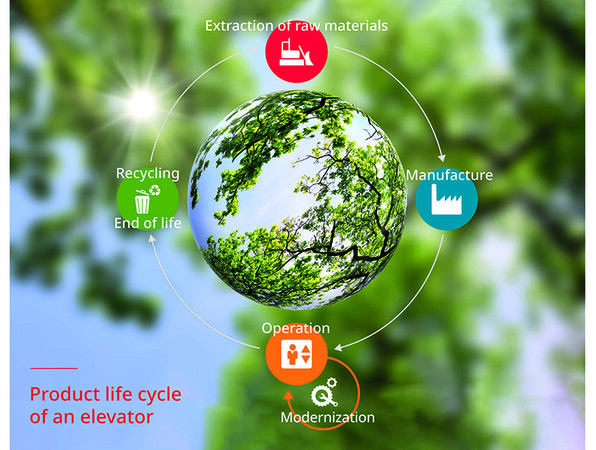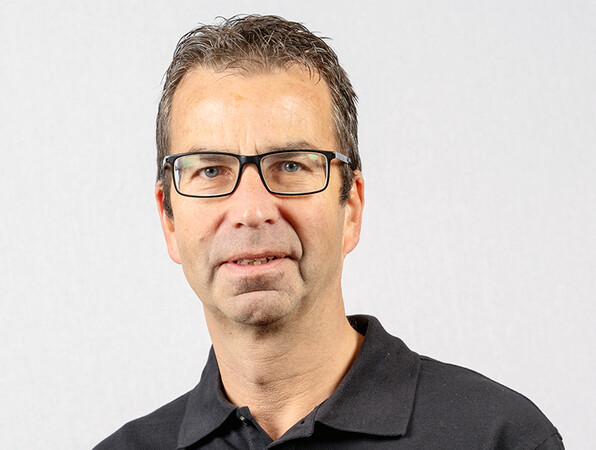Just like new: modernisation of hydraulic lifts
The climate crisis shows: the time of the throwaway mentality has passed - modernisation is the order of the day. This also applies to hydraulic lifts.
They can be brought up to the state of the art in manageable steps – and this at much lower costs than for a complete renewal.
By Tony Aschwanden
The complete renewal of an existing lift is an unnecessary waste of resources such as scarce raw materials and pollutes the environment through its processing and transport. What is often overlooked is that a complete renewal also consumes a great deal of so-called ‘grey energy’.
Grey energy refers to the entire energy quantity needed for all of the processes up- and downstream of operation, such as manufacture, transport, storage, sale and disposal of a product. This also includes primary products up to and including procurement of the raw materials and the energy used in the production processes.
To achieve the state of the art and meet all safety standards, replacing just one part of the lift or relevant components is quite sufficient. More travel comfort, better safety standards, improved energy efficiency, digital networking and as a result monitoring are further positive factors along with resource conservation.
Several investment steps also get you to your goal
 Modernisation instead of new construction: the ecological footprint of a modernisation is much smaller than complete replacement. Photo: © Bucher Hydraulics
Modernisation instead of new construction: the ecological footprint of a modernisation is much smaller than complete replacement. Photo: © Bucher HydraulicsMoreover, modernisation can also be carried out over several years to distribute costs. By contrast, a complete replacement must occur in one go and blocks important building sections for a lengthy period.
Another factor in favour of modernisation is the very different service life of the lift components. A building envelope has a service life of about 80 years. While rails and cylinders can likewise achieve this age with good maintenance, the service life of lift components such as drivers or controllers is much shorter. Phased modernisation makes it possible to replace components as needed.
For example, the modernisation of the hydraulic drive takes place about every 30 years, that of the lift controller every 20 years and the replacement of doors and cars every 15 to 20 years.
Modernisation in situ
Hydraulic lifts also offer decisive advantages when it comes to the modernisation of existing buildings that previously lacked any lifts. Thanks to their space-saving and flexible design, there is often a solution for retrospective installation and as a result upgrading existing buildings. On average, a hydraulic lift needs twelve percent less shaft space than a rope lift since it does not need a counterweight.
A single load-bearing wall is even enough for so-called backpack lifts, which also permit door openings in three directions. For example, the slender hydraulic lifts can also be installed retrospectively in a stairwell or inner courtyard.
The forces occurring act favourably in static terms directly on the foundation. The guide rails can be smaller dimensioned and if need be even integrated invisibly in the cylinders. The existing building statics do not have to be changed. Therefore, hydraulic lifts are outstandingly suitable for buildings without shafts. They are also the right choice for buildings that are to get an extra floor later.
Tailor-made energy-saving
 Condition monitoring: the electronically controlled iValve lift control valve is supplied by Bucher Hydraulics together with the iCon-2Daten for predictive maintenance. Photo: © Bucher Hydraulics
Condition monitoring: the electronically controlled iValve lift control valve is supplied by Bucher Hydraulics together with the iCon-2Daten for predictive maintenance. Photo: © Bucher HydraulicsA frequently mentioned disadvantage of hydraulic lifts compared to rope lifts is the higher energy consumption in operation. The technology has in the meantime made great advances, keyword frequency converter. Conventional feed pumps always run at full speed. The travel curve – i.e., acceleration, full speed and deceleration – is regulated via a valve. The excess oil is returned energy inefficiently to the tank, heating it unnecessarily. This can even require the use of an oil cooler. Energy is unnecessarily wasted here.
By contrast, frequency converters regulate the pumps from the speed zero. As a result, the pump only discharges as much as is needed for the ideal travel curve. At 25 to 30 percent energy saving, the additional costs for the frequency converter are amortised in very busy lifts in a relatively short time.
New technologies take energy saving another step further. Super capacitors, called supercaps for short, can be charged and discharge much faster than batteries. In addition, they withstand many more charging cycles. Bucher Hydraulics has made this technology available for lifts and can even retrofit it to existing aggregates with corresponding software modifications.
The principle involves the oil discharged by the cylinder during the downward trip driving the pump. This then impels the motor that acts as generator and in this way generates and buffers electric energy. At the next start-up, this energy is available and reduces the electricity drawn from the grid. This saves another 20 to 30 percent, which pays particularly great rewards in very busy lifts.
A new era in lift hydraulics
 Producing a lift has a much greater effect on the ecological footprint than its operating time. Consequently, an overall renewal is much less sustainable than modernisation. Tony Aschwanden, Product & Application Manager at Bucher Hydraulics. Photo: © Bucher Hydraulics
Producing a lift has a much greater effect on the ecological footprint than its operating time. Consequently, an overall renewal is much less sustainable than modernisation. Tony Aschwanden, Product & Application Manager at Bucher Hydraulics. Photo: © Bucher HydraulicsBucher Hydraulics is a member of the VDMA initiative BlueCompetence and has committed itself under the motto of ECOdraulics to developing and producing energy-saving, low emission, durable, light and space-saving products. One such product is for example the intelligent iValve hydraulic valve from Bucher Hydraulics.
Modernisation is even simpler with the "Multikit" that includes all components for the modernisation of a hydraulic lift without the need for replacing the lift controller. This means a mechanical valve can be replaced in just one day by the latest iValve valve generation. This is above all facilitated by a predefined conversion package, which includes the lift data already preset at the factory.
My conclusion is that phased modernisation of lifts is always better than total replacement, both in terms of investment as well as the ecological footprint.
The author is Product & Application Manager and has been working for Bucher Hydraulics AG in Switzerland for over 16 years. The company is a provider of innovative hydraulic drive and control technology for mobile and stationary applications.
This speaks in favour of modernisation: • Meeting current standards means enhanced safety
• Adjustment of performance to current needs
• Improved travel comfort
• Energy-efficient drive technology (reduction of previous consumption)
• Guaranteed spare part availability























Write a comment